



South Bay Chameleon Keepers (SBCK)
By Laurie Sageser & Dave Weldon
All photos by Bill Strand except where noted
Citation:
Sageser, L. & D. Weldon (2012). South Bay Chameleon Keepers (SBCK). Chameleons! Online E-Zine, November 2012. (http://www.chameleonnews.com/12NovSageserWeldon.html)
Editors Introduction: In 2007 Dave Weldon co-founded a chameleon keepers club in the Southern California area. Five years later, the South Bay Chameleon Keepers (SBCK) still meet monthly. In this article, Laurie Sageser interviews Dave to get to learn about the early years and what it has been like to get a successful club off the ground.
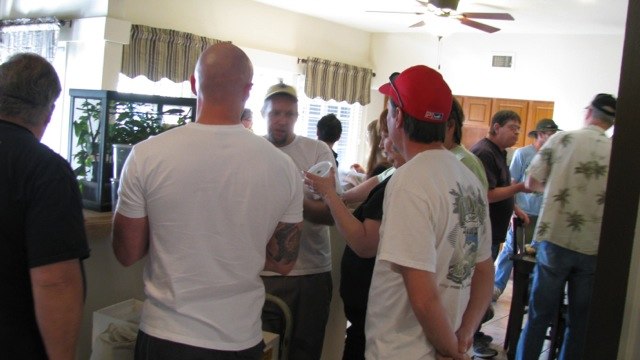
A typical SBCK meeting. New friends, old friends, chameleons, bugs, and usually an unexpected surprise or two!
Laurie: Good Morning Dave, I would like to take some time and get your perspective on the “South Bay Chameleon Keepers” group (SBCK) that you co-founded with Alice, getting it off the ground and going for all these years.
Dave: Good Morning Laurie, I am always happy to talk about the club and the success it has enjoyed.
Laurie: Could we start with a little of your background? Our readers will want to know whom they are hearing from.
Dave: I was born here in Manhattan Beach, CA where my wife and I continue to live. Our daughter Jennifer is currently working in New York. My wife Grace is the comptroller for a company that produces IMAX movies. I have been in the electronics industry ever since I graduated from college. I’ve been with the same major electronic test equipment manufacturer for the past 31 years, with 22+of those years as an applications engineer, where I help the sales teams sell it and the customers use it. I deliver training, lectures, and consulting related to the product lines I support. I’m just having too much fun to do something else. I think the draw for me is doing the thing that I like the best which is helping people. I like the satisfaction of assisting with people with technical problems and helping them be successful. That’s why it has been so much fun with chameleons because after I learned how to take care of my chameleons, I was then able to pass that information along by helping other keepers. As my chameleons say: “Time is fun when you’re having flies” :- ).
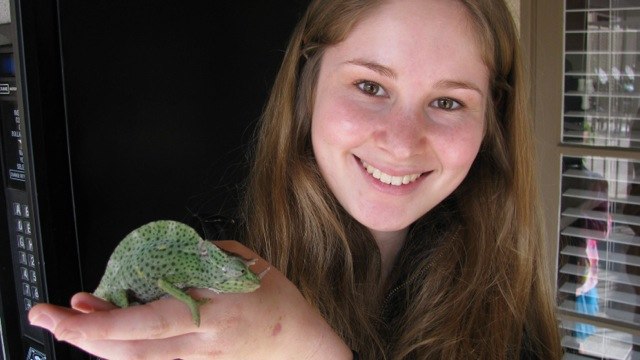
Thea and a new juvenile deremensis
Laurie: how did you come up with the idea for the club and why?
Dave: Alice, one of the local Chameleon Forums members, and I got to talking about how to find more local keepers, especially ones who haven’t yet discovered the Chameleon Forums. Alice and I conceptualized what was to become the South Bay Chameleon Keepers group, otherwise known as SBCK.
Laurie: From those decisions, how was the club brought to life?
Dave: We needed to find people would be interested getting together for monthly meetings. We decided that one way to do this might be some kind of announcement in the local newspaper. I contacted the “The Daily Breeze” in Torrance, CA and asked about what our options were. I was directed to a reporter who told me she could write-up an article and maybe even bring a photographer. I was the only one able to sneak away from work, back home for the lunchtime interview. The photographer took photos and reporter wrote down lots of notes about our chameleon keeping and our interest in connecting with other local keepers.
Laurie: Did the reporter do a good job of presenting your ideas for the club to the public?
Dave: She went far beyond our expectations! I was expecting to see a little paragraph hidden on page twenty about people wanting to form a chameleon club. When I went to get the paper, there it was splashed on more than half of the front page, complete with beautiful pictures, followed by more information and more photos on another page. On a funny note, a new movie release with some kid named Harry Potter was discussed on the bottom of the front of the page – well below us.
Laurie: It sounds like the article was an excellent vehicle to get your information out to the public and other chameleon keepers. Did you get a good response from the newspaper article?
Dave: We got a good kick-off response to the article. The important thing was that the email address; SouthBayChameleonKeepers@gmail.com was in the article and we started getting emails from a number of keepers in town right away. One was only a few blocks from my house, and most were within 10-15 miles of the South Bay area. That facilitated our getting the first keepers group together. The article was in July 2007 and the first meeting was in September.
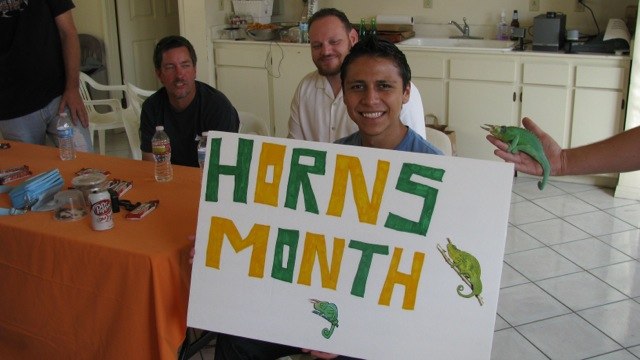
SBCK meetings have special guest speakers or sometimes themes. Johnny Hernandez hosted Horns month where we had species with 1,2,3,4, and 5 horns. (our quad had five obvious horns, but it was stretching it to say it was six!)
Laurie: At this point, were you just getting together a small local group or did you already visualize the club that was to come?
Dave: We decided to have our first meeting at a place called Reptile Finders, a store in Lomita, California. There were only four of us there, Alice, Howard, Nicole and myself. As I said, we had that first meeting in September and one of the things we decided was to form a sort of co-op for buying insects. I was already buying shipments of around 100-500 silkworms a month for my chameleons, and eventually selling-off my excessively overgrown ones to the reptile store. As the club gained more members, we would order something closer to a thousand silkworms at a time so that we could divide them amongst the group’s keepers. That got us a quantity discount on the price and saved on shipping costs by consolidating our orders into one. We also had other keepers buying and sharing bulk quantities of crickets purchased locally from a commercial cricket operation. Later, when Kevin Zamp joined the club, he would drive to Mulberry Farms before the monthly meetings to pick-up thousands of silkworms along with superworms, hornworms and other feeders too. We were still paying less than retail even after he covered all his costs.
The club became more stable, but we still kept things simple. There were always the insects plus we had guest lecturers from time-to-time. We held several meetings at Dr. Tom Greeks office and we had Dr. Geoffrey Stein come give a lecture at one of our other meeting locations. We also had people come in who were involved in the industry. One business, that produces screen enclosures available nationwide, came to a meeting. It was this enclosure company that was given our feedback and design ideas that went on to produce drain pans now supplied through LLL Reptiles and elsewhere. So if you see the drain pans at LLL Reptile, those were influenced by discussions at the club.
Laurie: I have a number those drain pans downstairs in my chameleon room. They work very well. Are you proud of the club’s part in the success of the drain pans?
Dave: Yes it is good to see a club have an impact on industry.

Tylene Duncan and Karen Venaas. Making friends, warm and cold blooded, is what it is all about!
Laurie: What were some of the club structuring ideas that was tossed around?
Dave: There were discussions about whether or not we should collect dues and raise money for projects etc. Alice and I thought it was better to just keep things simple. Just come to the meeting to share ideas, share in the co-op feeders, share selling items that you might have, and even chameleons you have for sale. Or you might post a chameleon for sale on Chameleon Forums (CF) and then have a meet-up at the club to finalize the purchase. For new keepers, buying a chameleon at a meeting meant that they had a great opportunity to ask plenty of questions before going home with their new ward. Part of the attraction to the club is people bringing chameleons that are for show as well as for sale.
Laurie: You told me that you always had a meeting even if only three people showed up. Did that happen, and why did you go ahead and have the meetings?
Dave: The consistency of having an event every month made it possible for a person to decide at the last minute if they were going or not, with no strings or commitments. Whether it was at the initial reptile store meeting, or when we had them in a meeting room where Alice worked, we had the meetings. We also had meetings at Steve’s (thanks Steve!) workplace in downtown LA. We had meetings there for many months then moving on to an office in Santa Monica where Nathan (thanks Nathan!) worked.
One of the challenges of the club was a free location for the meetings. We would usually have 10 to 20 members at any one meeting with a couple topping 30! That might have been the meeting when Dr. Stein was giving the lecture plus Q&A. The big thing at the meeting was sharing what you were doing with chameleon keeping. In the early years it wasn’t encouraged to bring your chameleon because it might be overly stressful to bring them at night. At that time, the email meeting invitation mentioned that if you were bringing a chameleon; make sure that it was one that was O.K. with being up past bedtime. With the chameleon meeting moving to a weekend day that is much less of an issue.

Kevin Zamp and his melleri
Laurie: Sounds like the club is pretty stable at this point. You once mentioned that the club participated in some of the big Reptile Shows. Tell us more.
Dave: We were invited to have an information and education booth at the Pomona Reptile Expo. We took advantage of that invitation to have a lecture and a slide presentation. It was a 48 page PowerPoint presentation called “The Basics of Chameleon Keeping” with a tagline: “It’s all about the Husbandry.”
Laurie: Where did your slide presentation finally end-up? Do you still have it and use it at club meetings?
Dave: I passed on the slide set to Bill Strand.
Laurie: Nice, I know how to find him, since he is currently responsible for the SBCK.
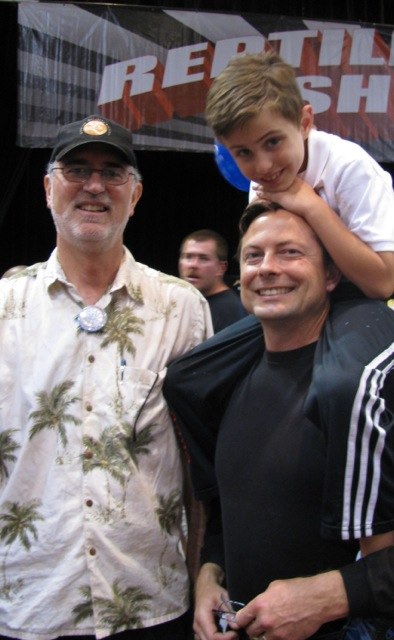
Dave Weldon and Bill Strand at the Reptile Super Show in San Diego, CA
Dave: Bill has the slides and he is welcome to do whatever he wants with them. If he wants to put text with them and turn them into something that can stand alone, that would be great.
Laurie: Good, I will twist his arm! This would be an excellent resource to be loaned to new clubs trying to get started. Back to the expo, how did it work out for the club?
Dave: It worked out great! The fun part about having the SBCK booth at the shows was when members would come to the booth and stay to meet to greet new keepers. When other members were in the booth and people who didn’t know about SBCK and/or about keeping chameleons healthy, we would all share the knowledge of the members in the booth. But it was not just me providing information; we would often have two or three other SBCK members in the booth, ready to talk about chameleon husbandry. We would have the PowerPoint slides up and running on a laptop ready flip through to any husbandry topic to use as talking points with the new keepers.
The club meetings always managed to do well as long as we followed our club platform and kept it simple. We just went with talking about chameleons, or we would have a show and tell time. Sometimes we would have discussion time with a circle of chairs, and it was: “Who wants to talk about what?” Sometimes I would just throw out a topic or I might have a topic with three or four slides to toss-up on a projector. I even had a pc, sometimes online, to play particularly interesting YouTube segments about chameleons. Whether it was one of the fancy BBC productions or just a simple video someone had put together that had useful, educational points in it, we might play that on the big screen.
Laurie: Now you said you would share something funny within the club, I know that you have them.
Dave: It was at one of the shows with the SBCK booth. One of the chameleon breeders near us was talking to someone researching chameleons. They were asked if chameleons can live on Ficus plants. The answer was basically yes, yes they can and the person said O.K. and then they left. Then later I was talking with Chad (Tiki Tiki Reptiles) at his booth. Chad said a person came to his booth said someone at another chameleon booth had told him chameleons can live off of just eating Ficus plants, and asked is that true? Chad chuckled and set them straight! That is how things get rumored around, next you hear, my chameleon died because it never ate the Ficus plant. Crazy stuff like that has happened.
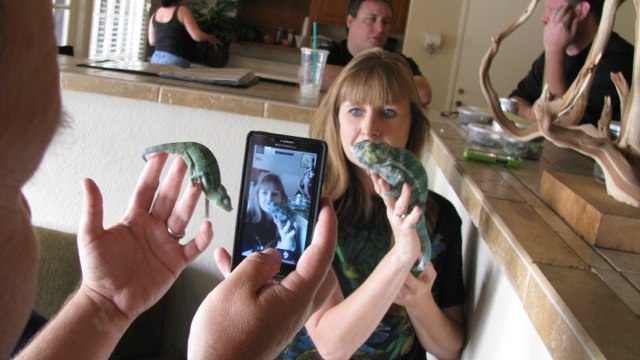
Picture taking is always enjoyed. Here Rodney balances camera and color-up inspiration while Ginger Scott patiently poses. Chameleon people have had to learn patience!
Laurie: Did anything funny ever happen at one of the meetings? I know it was not at a meeting but I like your story about the chameleon in your hair.
Dave: In the early days, before chameleons were in my future, I was out picking up a feeder mouse for my Rosy Boa and I felt something grasping and kneading through my hair. I didn’t want to pull away too quick because I didn’t know just what was happening. I slowly pulled my head away and there at about six feet off of the floor were vines strung around for a free-ranging Jackson’s chameleon. Back in the 80’s, I had lots of hair and had not thought about a Jackson’s chameleon styling it. I would have never guessed at that time that chameleons were to be in my future.
Laurie: You were so calm. I am just not like that. Now could we talk about the Veterinarians, Dr. Mader and how he knows Dr. Greek and Dr. Stein?
Dave: That was one of the things we discovered by having Dr. Stein at our chameleon meeting. He related the story about his days in vet school. The one anecdote that remains in my memory is his friendship with Douglas Mader. Dr. Stein was always on the path to specialize in exotics, especially reptiles and there is a point in your vet training where you have to pick your specialty and exotics take extra years of study. One of his good friends in vet school, who was going to be something like a large animal vet, was convinced by Dr. Stein that he should really get into exotics, particularly reptiles, enticing him with thoughts of working at the zoos and how it would be a much more interesting thing than being a large animal vet. That student was Dr. Mader. So if Dr. Stein had not met up with Dr. Mader we might be reading about cows in Dr. Mader’s research. But fortunately for us, we have him as the author and expert on “Reptile Medicine and Surgery” instead.
Dave: I visited with Dr. Greek, and he said that in fact when he had done his original residency training in the field, it was with Dr. Mader, when Mader’s office was in Long Beach California. So it’s kind of a small world when you can connect Dr.’s Mader, Greek, and Stein both professionally and personally.

Occasionally, the SBCK will host special guest speakers. Pictured are the Nozakis from Amazing Blue Reptiles. From left to right Ed Snow, Victor Nozaki, Bill Strand, Jim Nozaki, Mari Nozaki. Photo by Dave Weldon
Laurie: Can you give me some words of wisdom for new keepers.
Dave: If it’s available to you, it’s really helpful to find somebody that you can visit with that has thriving chameleons. Seeing successful chameleon setups in person can really help ensure that you haven’t missed some of the finer points because it’s not always intuitively obvious to a new keeper what a good setup is and what it isn’t. Just the simple things of setting up the distance of a light can be a matter of life or death. I think being able to have somebody show you their set up face-to-face and then, later showing them what you have put together, face-to-face goes a long way. Now if you are in a situation where you don’t have that available, the next best thing is never assume that what you’ve got is correct. It’s that classic: “I’ve read everything. I bought a UVB light. I know I’ve got everything right.” Instead, assume that you don’t have everything correct. What you can do is take quality, well lit, well focused, well composed photographs of everything aspect of your setup and chameleon, including how it all relates to the positions your chameleon basks and rests. Also, note how the enclosure relates to the rest of the room so that other keepers can do the equivalent of being there looking at your setup. Being able to see photos from multiple angles, seeing what the lighting looks like and even having it to scale knowing what those distances are, knowing where the perches are inside the cages relative to the light, knowing all of those things and then making sure that you are listing all of the things you need to tell someone in the chameleon forums will be very helpful in getting things sorted out. Listing what the products are by make and model not just: “I have a UVB light.” Don’t panic! Get advice!! You will get this figured out. The other thing I would say is minimize handling your chameleon, especially during the first days, weeks, or months. Before you handle you chameleon, be sure you can recognize what an unstressed/stressed chameleon looks like. You won’t make the mistake of: “Oh my chameleon is so unstressed it will go to sleep in my hand”, only to find out that it was super-stressed and its response was to close its eyes.
Laurie: I think most of us have been there before.
Dave: In its mind it was thinking: “I might as well just close my eyes because in a minute I’m going to be eaten.”
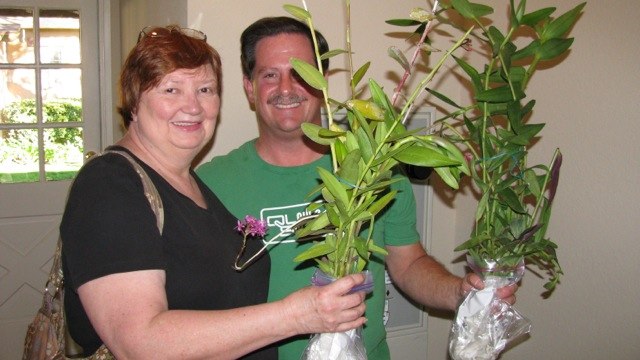
Laurie and Lance talk orchids. Laurie, the author, joined in a meeting during a visit to Southern California
Laurie: Could you add something about working with Elisa from ChamEO?
Dave: Somewhere along the way, I think Elisa and I got to chatting on the chameleon forum. I was raising massive quantities of fruit flies at the time. I was making something like 30 cups at a time for feeding babies and so forth and when I had massive quantities of them I was sharing them with Elisa. So I would drive out and see her wonderful setup at Chameo.org and all of her enclosures with all of the chameleons that she was re-habilitating. We even had a few SBCK meetings at her location and we also co-shared a booth where could do the combined SBCK and Chameo.org education and outreach booth. We shared a booth several times. It was loads of fun to have multiple people in the booth at all times. Another fun event at several of the SBCK meetings was when several of us would bring our microscopes. We would do a “poop-off” where keepers would bring in chameleon poop and we would do fecal floats and smears. We could not only look at it with the microscope eyepieces but I sometimes hooked up my camera to my computer and we did a big screen projection so that we could all look at samples together, looking to spot parasites. Quite a few people had purchased microscopes over time but not everyone was real comfortable with doing fecal floats. We did some bulk buys where I bought a couple of gallons of Fecasol and a case of Fecalizers so we would share the cost and keepers could go home with a pint or a quart of Fecasol and some fecalizers and at least feel comfortable with doing the initial start-up tests on their own.
Laurie: Dave it has been a pleasure, as always talking with you. Thanks for taking the time to share this information with our readers.

Dave Weldon
For further information on the South Bay Chameleon Keepers group send an email to southbaychameleonkeepers@gmail.com or like the SBCK Facebook page.

Laurie Sageser
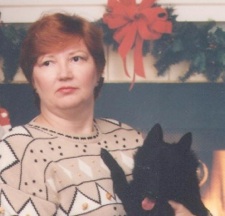
Laurie Sageser, was born in California. Her career managing Legal and Compliance for several trust companies ended the day she turned 55 and retired. After that, she and her husband, David, moved from California to Montana. She now happily stays home with her chameleons and quilting.
Photo courtesy of Laurie Sageser
Dave Weldon

Dave Weldon has been working in the high-tech electronic test equipment industry for over 30 years and has a keen interest in the technical aspects of UVB lighting for chameleons. He has kept a number of chameleon species since 2004. In 2007, he co-founded the “South Bay Chameleon Keepers” group that meets in the Los Angeles area.
Photo courtesy of Robert Casillas









Join Our Facebook Page for Updates on New Issues:
© 2002-2014 Chameleonnews.com All rights reserved.
Reproduction in whole or part expressly forbidden without permission from the publisher. For permission, please contact the editor at editor@chameleonnews.com

